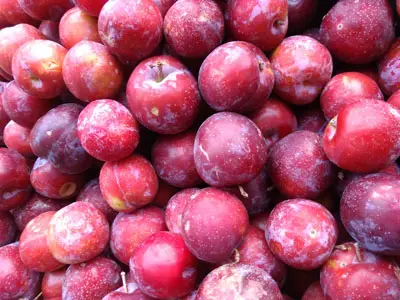Plum maggots are most commonly caused by the plum moth. The maggots live inside and eat the plums which sadly leads to the affected fruits becoming inedible. They are most commonly found in plum trees and the caterpillars often aren’t spotted until the fruit is cut open.

The life cycle of this insect pest begins in the spring months when the female moths lay their eggs. Unless you spot the eggs once they are laid you will not realise you have pink maggots until it’s too late. If you spot the adult moths, however, you can take steps to control infestations by using pheromone traps.
Jump To...
Fruit Trees Vulnerable to Pink Plum Maggots
It can be quite soul-destroying to find your crop, or part of your crop, destroyed by pink plum maggots. Often the problem goes undetected until the caterpillars have already made their way into the fruits. Knowing which trees are affected gives you a heads up.
- Plum trees – In particular, Victoria and Czar varieties
- Damsons
- Greengages
Pink Plum Maggot Identification – Lifecycle
By understanding the life cycle of pink maggots you will know roughly their location at any given time in the year. Knowing where and when to look for these plum tree pests can go some way to help control and even prevent infestations of pink maggots.
Spring
Spring sees the beginning of the pink maggot life cycle as this is the time the adult female moths lay their eggs. These are laid behind the fruits or on leaves around May and June time.
Summer
The little creamy eggs hatch one to two weeks later and then the maggots burrow their way into the fruits. They are pink with brown heads and are around 12mm long and feed on fruit close to the stones.
Autumn
Once they have fully fed, they emerge from the fruit in late summer or early Autumn time. At this point, they pupate inside silk cocoons.
Winter
The adult moths are not active over the winter months and overwinter under loose bark or somewhere else safe.
Pink Plum Maggot Damage
Often, the first signs of pink plum maggot infestations are when you find them after cutting open your fruit. There are a few other indications though, including misshapen fruit, discolouration, and early drop of fruit.
You may also see their brown excrement, also known as “frass” and evidence of dried drops of gum near the hole. Pink maggots are often confused with another fruit pest known as pocket plum. Pocket plum is, instead, a fungal infection affecting plum trees.
Pink Plum Maggot Control
To be effective in controlling pink plum maggots, the problem needs to be detected before they enter the fruits. Following this then, your timings need to be precise for any action you decide to take.
There are lots of viable options when it comes to controlling pink plum maggots so it’s a matter of finding a method to suit your fruit gardening preferences. You can also use pheromone traps alongside other methods which can increase your success at identifying and dealing with infestations.
Organic Control
- Moth traps can be used to identify if you have plum moths in your garden. This will help identify your next course of action. Trapping the males will also mean there will be fewer eggs becoming fertile.
- Small infestations can be left and you should still get a good crop even with some diseased fruit.
- Encourage the birds and hedgehogs in by offering nesting places, bird feeders, and water stations.
Pesticide Control
- Contact insecticides can be used and these involve spraying the caterpillars directly and usually takes multiple attempts.
- Some sprays are also absorbed by the leaves and move around so can be more successful than others.
- Fruit will need careful cleaning before consumption after using any pesticides.





I have a victoria plum tree and I put the moth trap up in early May and changed it when recommended to cover during the season but still had the maggots inside and misshapen fruits and some looked mouldy.
Good afternoon
My Victoria Plum tree has become infested with plum moth larvae for the last 2 seasons . I now want to apply an insecticide spray .
In what month should I apply the spray ? There seems to be contradictory advice on the internet .
Many thanks
Gareth Jones
Is there an organic remedy for plum maggots.?
Hi Colin, Vitax are the manufacturers of plum moth monitoring traps and they also have a product called Vitax Organic 2 in 1 Plant Invigorator. This can be used to remove eggs without affecting other beneficial insects. I hope this helps!